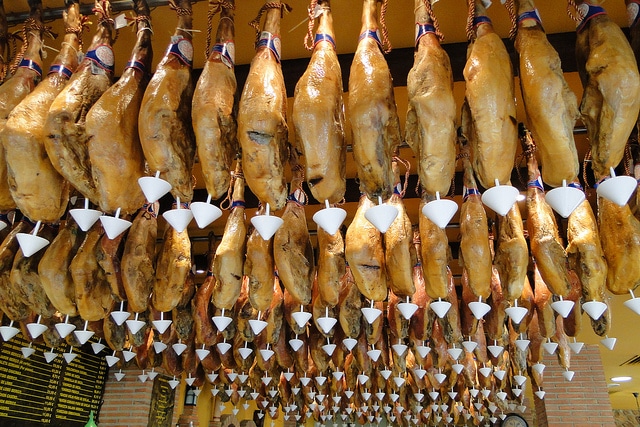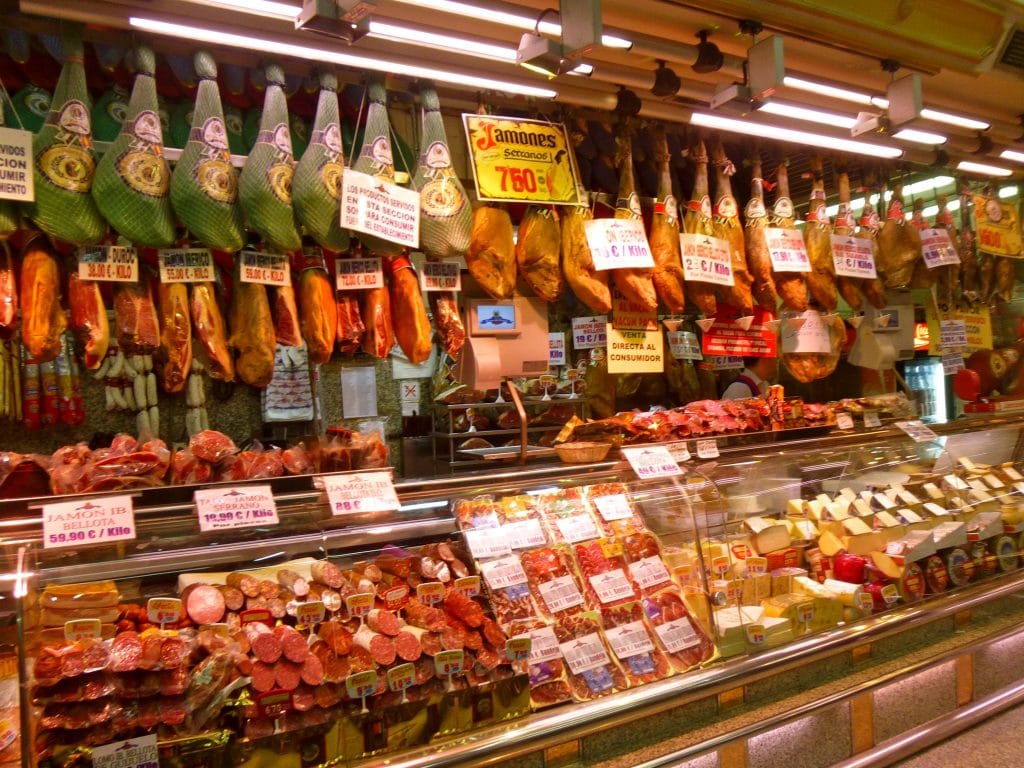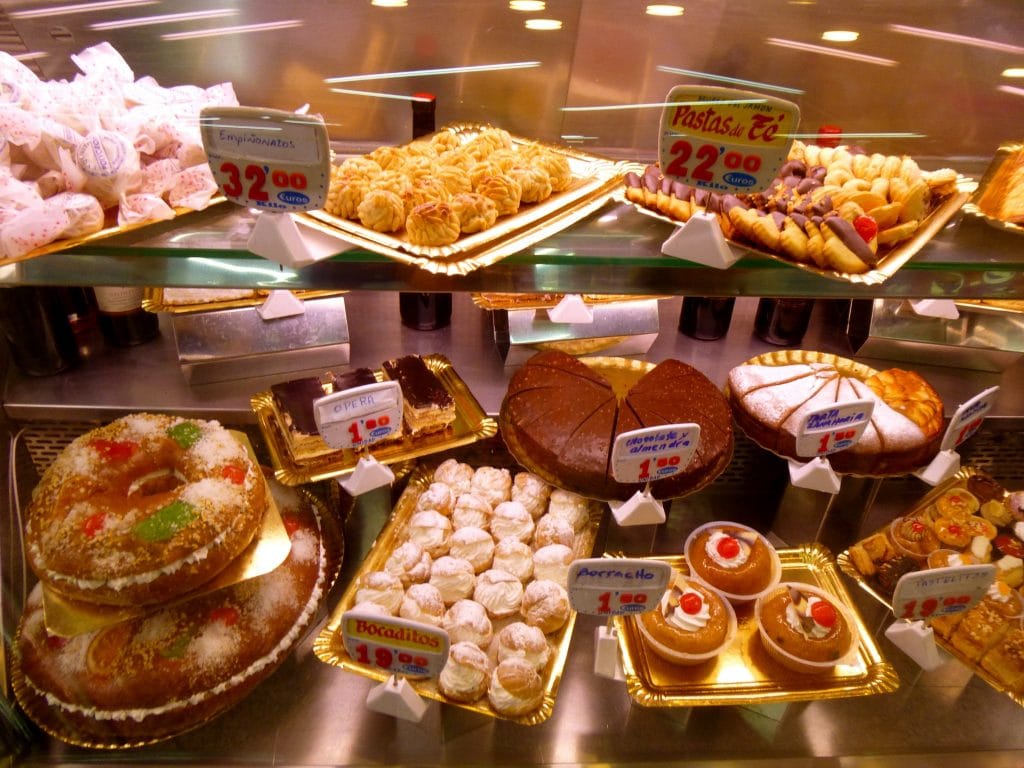
There are some experiences you just can’t miss: visiting the Eiffel Tower in Paris, cruising the canals in Venice, taking a picture in Rome’s Colosseum, tasting Jamón Ibérico in Madrid. Okay, the latter may be a little less obvious, but neglecting to indulge in the finest of Spanish cuisine would be an undeniable traveling travesty.
The Story Behind The Hanging Ham
Spain produces a mind-blowing 40 million hams per year, with jamón popping up on tapas plates and in dishes for almost every meal of the day. Approximately 5% of this meat comes from Ibérico hogs. These black hoofed, nearly-hairless, dark-colored pigs have been appreciated in Spain for centuries, even depicted on walls by cavemen. These fatty animals produce meat that can be cured for up to three years for a top quality product with complex and intense flavor and unparalleled sweetness.
Spaniards don’t joke around when it comes to rearing, slaughtering and curing these animals, regulating this process with arguably one of the most stringent policies of any food on Earth. Hams are typically labeled with the pig’s diet and geographic origin, for example, with the finest called Jamón Ibérico de Bellota (acorn). These free-range pigs are raised in the oak forests (dehesas) along the border between Spain and Portugal, and are fed only acorns during the final period of their life. After slaughter, or “sacrifice” as they call it in the region, their legs are covered in Andalusian sea salt and cured for 36 months before being ready to be served.
Anyone wandering the streets of Madrid will see dozens of hams hanging from store windows and even the ceilings, a sight with both historic and practical relevance. Practically speaking, hams are hung so gravity can pull the grease and fat down into the small plastic cups at the bottom of the ham leg. Hams lose about half their weight during this process, which helps saturated fats change into healthy oleic acid (also found in olive oil). Historically speaking, during religious turmoil, shop owners wanted to make it perfectly clear they were not part of the persecuted Jewish population. Hanging hams in windows helped send the not-so-subtle message: “We Eat Ham, No Jews Here”.
An Authentic Experience Of This Spanish Delicacy On A Backpacker’s Budget
After a couple days in Madrid, butcher-shop window décor quickly becomes the norm; however, one day, a shop gone hog-wild with jamón stops me in my tracks.
“Museo del Jamón?” I wonder out loud, trying to peer beyond the hanging hams to see if track lighting illuminates captioned display boxes of immortalized foods inside. Either that or a tourist trap filled with Americans getting their travel books greasy as they gorge themselves on unreasonable portions of cheap meat as an inauthentic experience designed for people to check this culinary experience off their “to-do” travel list. With extra time since surrounding stores have closed for siesta, I decide to check out this meat shrine for myself.

Hanging hams at Museo de Jamon in Madrid, Spain. Photo courtesy of Katie Foote.
Disproving both of my expectations, the joint is filled to the brim with locals enjoying a hearty snack to tide them through until a night-owl dinner around 9 or 10pm. With plates of tapas, glasses of beer and piles of crumpled napkins filling the counter, I decide to pursue the menu on the perimeter before elbowing myself a space at the bar. Ham omelets, ham croquettes, ham with melon, creamy cheeses, chorizos, warm croissants and crusty breads are all options. Best of all is the low prices. For example, a ración/bocadillo (large tapas serving/filled roll) starts at €2.50 (about $3.40 USD) and can go much higher depending on the quality of the jamón. A combination meal of two plates with bread, drink and dessert only sets you back €9.50 (about $13 USD) and includes Spanish specialties such as paella, gazpacho and calamari.

Spanish tortilla, ham and cheese croissant with “bitters without alcohol” at Museo de Jamon. Photo courtesy of Katie Foote.
The no-nonsense, apron-donning man behind the counter has my order in front of my nose before I’m done struggling with the Spanish pronunciation. I bite into my buttery ham-filled croissant, surprised to find a meaty snack that tastes almost as indulgent as the chocolate and churros—another Madrid culinary tradition—that I tried the night before. I am instantly enamored with this hearty and authentic food that fuels first-time visitors and tourists alike. I sip on “bitters without alcohol”, a quirky choice of beverage that I’ve never seen before coming to Spain and eye the artfully displayed pastries, hoping to find room for dessert.

Spanish desserts and pastries at Museo de Jamon. Photo courtesy of Katie Foote.
The Spanish have a way of celebrating the simple pleasures in life. Jamón Ibérico may be the country’s culinary crown jewel, but by offering various options of the quality of this meat, from affordable to gourmet, Spaniards share the love of ham with a wide population. This allows locals and visitors alike to celebrate snacking and socializing culture surrounding this popular treat. Europe’s other top attractions may make for better photos, but I doubt they taste this good.
*Featured image courtesy of Zachary Leetch. Top photo. Hanging hams at Museo del Jamon. Photo courtesy of Adam Jones Ph.D.
Contributed by guest author Katie Foote

Jessica Festa is the editor of the travel sites Jessie on a Journey (http://jessieonajourney.com) and Epicure & Culture (http://epicureandculture.com). Along with blogging at We Blog The World, her byline has appeared in publications like Huffington Post, Gadling, Fodor’s, Travel + Escape, Matador, Viator, The Culture-Ist and many others. After getting her BA/MA in Communication from the State University of New York at Albany, she realized she wasn’t really to stop backpacking and made travel her full time job. Some of her most memorable experiences include studying abroad in Sydney, teaching English in Thailand, doing orphanage work in Ghana, hiking her way through South America and traveling solo through Europe. She has a passion for backpacking, adventure, hiking, wine and getting off the beaten path.








